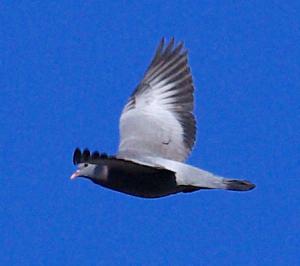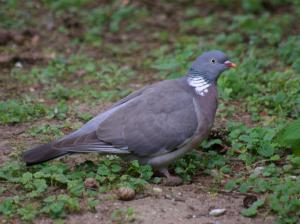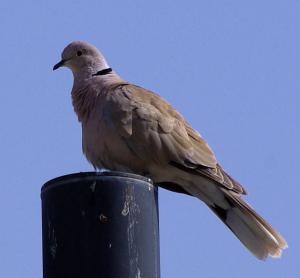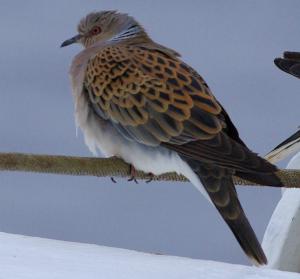


In Nottinghamshire, the Stock Dove is a fairly common resident, there is one record of a bird being ringed in the summer in Nottinghamshire and found dead eighteen month later in France (Birklands Ringing Group). It breeds well in wooded areas with trees old enough to have holes in them such as Sherwood Forest. It is also satisfied with nest boxes in Clumber Park and under the viaduct at Bennerley.
In the East Midlands the Stock Dove numbers have declined by about 40% between the years 1995-2007. It is now an amber listed bird.
Sterland in his Descriptive List of the Birds of Nottinghamshire {1879} considered the Stock Dove as "not uncommon". Stock Doves increased in the nineteen century, but the population collapsed substantially in the 1950s because of fall in breeding success caused by organochlorine seed dressings. {British Birds V77}. Numbers recovered rapidly when these substances were controlled.

The Wood Pigeon is an abundant bird in Nottinghamshire with some immigration of birds in the winter, the local birds not moving far. In the East Midlands, numbers have increased by 25% between the years 1995-2007.
It can be found all over Nottinghamshire, with the possible exception of the really built up areas with no local parks or roadside trees. It was once a woodland bird but has adapted well to modern agriculture and to modern suburban living. Sterland in his Descriptive List of the Birds of Nottinghamshire {1879} considered the Wood Pigeon to be much commoner than the Stock Dove.

In 1930 the nearest the Collared Dove occurred to Nottinghamshire was the Balkans. A rapid spread across Europe led to the the Collared Dove first breeding in Nottinghamshire around 1960. Its spread in Britain was more rapid and more complete than the expansion of the range of the Turtle Dove in the nineteenth century. The initial places to be occupied in Nottinghamshire were Worksop and Newark. Nottingham was reached by 1963. Attenborough had a roost of around 400 birds in the 1980s, but numbers there have declined since then. Numbers in the East Midlands however have increased by about 50% between the years 1995-2007.
In Nottinghamshire the Collared Dove is found around the greener suburbs, villages, parks, and farmyards, but not so much in the large open fields of modern farming.

The Turtle Dove is a declining summer visitor to Nottinghamshire. Its habitat is one of untidy hedges, scrub and small woodlands.
After J. Whitaker (Descriptive List of the Birds of Nottinghamshire {1879}) saw his first Turtle Dove in 1868, it increased steadily after that and in the early 20th century he considered it was "well dispersed over the county". The population continued to remain stable or even slightly increase up to the 1970s (Atlas of Breeding Birds of Britain and Ireland – 1976{Sharrock})
Since 1977 it has declined steadily and is only regular in Nottinghamshire in the eastern half of the county. Nationally it has declined so much over the past 30 years that it is on the Red list of Birds of Concern. An study noted in British Birds V98 No2 found that less Turtle Doves were starting nests in August than forty years ago in the 1960s, hence the breeding season was somewhat shorter. Also each Turtle Dove pair was only producing 1.3 fledged young in the 1990s cf 2.1 in the 1960s. This was put down to more intensive farming practices, removal of hedgerows, less split corn in the stubble, less clover leys etc.
Any criticisms, corrections or comments to the author Derek Huskisson

This work is licensed under a Creative Commons Attribution-Noncommercial-Share Alike 2.0 UK: England & Wales License.